4.5 - Marketing mix (7Ps)
1/58
There's no tags or description
Looks like no tags are added yet.
Name | Mastery | Learn | Test | Matching | Spaced |
|---|
No study sessions yet.
59 Terms
Marketing mix
Marketing mix is a set of decisions to be made in product marketing.
Different marketing mixes apply to the two types of products.
For goods, there are 4 decisions to be made:
Product
Price
Promotion
Place (Distribution)
For services, in addition to the 4 decisions above, there are three more decision to make:
Processes
Physical evidence
People

Types of consumer goods
FMCGs — fast-moving consumer goods. These are the goods that do not expire quickly but wear-off quickly and thus are purchased often. For example, toilet paper, tooth brush, toothpick, etc. All these products can be stored for centuries, but since people use them often, they make repeat purchases of FMCGs often too. This explains the “fast-moving” bit of the concept.
Perishables — goods that expire/decay quickly. For example, food.
Durables — goods that have a long lifespan: washing machine, car, laptop, smartphone.
Speciality goods — goods with unique characteristics that are usually distributed through limited distribution channels only. For example, designer clothes.
Product life cycle
Product life cycle is the succession of stages that a product goes through from launch to decline. The two variables of the product life cycle are time and sales. The stages that the product goes through are:
Research and development (R&D)
Launch/Introduction
Growth
Maturity/Saturation
Decline
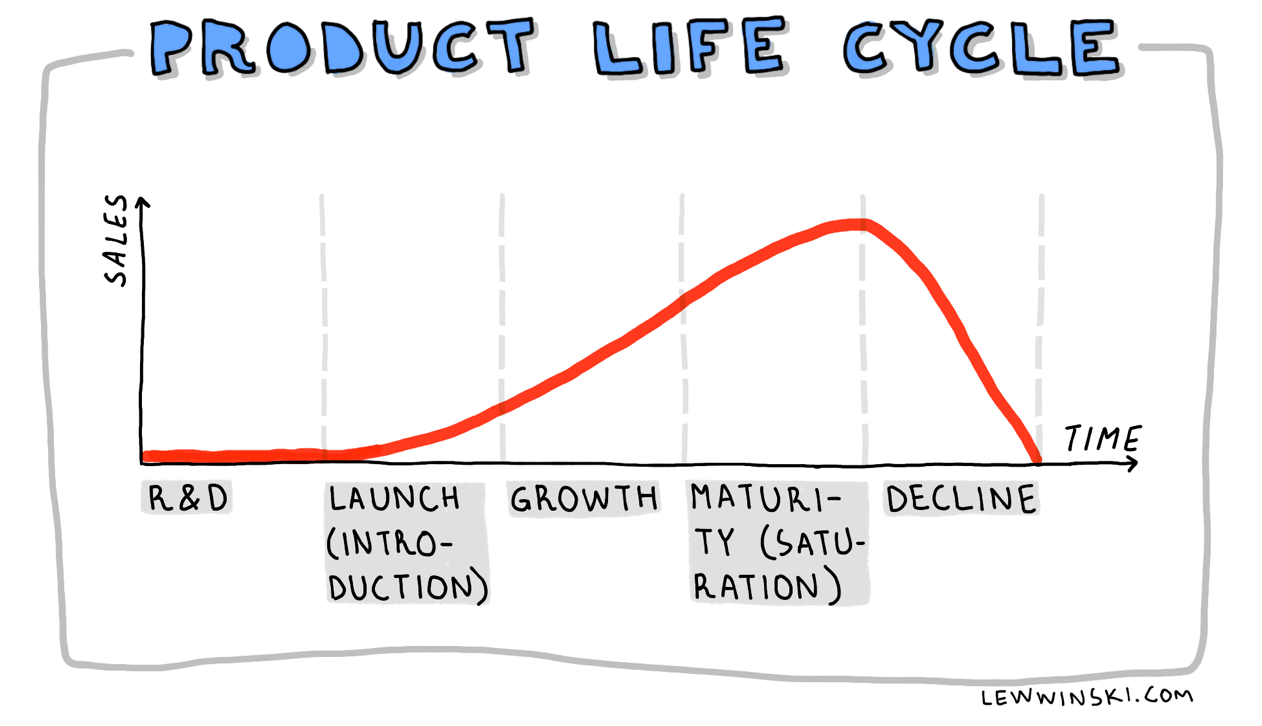
Product portfolio
Product portfolio is all the products provided by an organisation. For example, Apple’s product portfolio is iPhone, iPad, MacBook, Apple Watch, Apple TV and all other products that they offer…
Product portfolio analysis refers to evaluation of all the products provided by an organisation.
Organisations are really interested in knowing which products sell well, which are not, when the best time to stop manufacturing certain products is, when to increase production, etc. '
Overall, it’s really cool to know as much as possible about one’s product portfolio because it can help to make more money more efficiently.
BCG Matrix
BCG matrix is a product portfolio analysis tool that examines the products in terms of market share and market growth.
Once you know your product portfolio and you have data about your market share and market growth, you will be able to put all the products you offer into 4 categories using BCG matrix from the picture below.
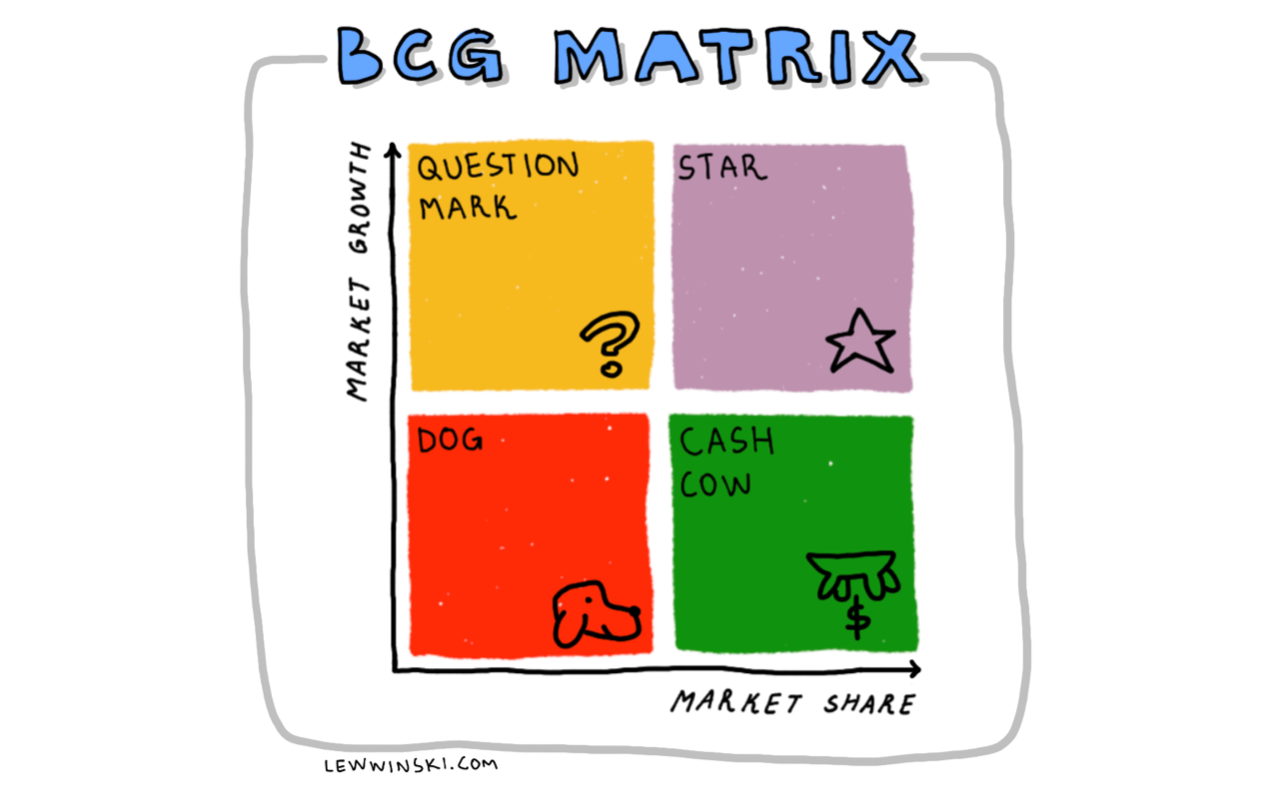
Research & Development
👨🏻🔬 R&D is the research and development stage of the product life cycle.
One thing that is often developed at this stage of the product life cycle is a prototype — the initial version of the product from which the later versions are developed.
In some sources, you will not even see R&D as a stage of the product life cycle, because at this stage there is no product and no sales yet… Just like the product, the remaining elements of the 4Ps (price, promotion, place) are also in the development stage.
At this stage, there is high reliance on investment, because R&D requires heavy investment.
At the same time, there are no profits and there are only cash outflows.
Thus, marketing managers try to move on to the next stage as soon as possible, in order to generate profits to cover all the R&D costs.
Introduction
🚀 Introduction (or launch) is the stage of the PLC when the product becomes available for purchasing for the first time.
With regards to the 4Ps, product at introduction is usually star or question mark : market share is either high or low in a growing market.
Price depends on elasticity of demand - means that the more alternatives a product has, the lower the price at launch stage is likely to be.
And, vice versa, if the freshly launched product is unique and does not have many alternatives, then the price is likely to be high.
The aim of promotion at this stage is to increase awareness, to let as many people as possible know about the product.
With regards to Place, there are few distribution channels used because it is the very beginning of sales, so product is sold through a limited number of channels.
Reliance on investment is still high at this stage, not because of R&D costs, but because of promotion.
It is important to let customers know about the new product and the only way to do that is extensive promotion.
Costs usually exceed sales revenue at this stage, so no profits are made yet.
Cash flow is still negative but starts to improve slowly, as costs decrease and revenues increase.
Growth
📈 Growth is the stage of the product life cycle when sales are growing at a relatively fast rate.
At this stage, organisations start to have a chance to start using economies of scale, because sales are growing, output is increasing and it is a perfect opportunity to decrease average costs with the increase in scale of production.
Managers love the growth stage! It shows that they are doing their job well because the sales figures are increasing at a fast rate.
However, managers start to have a new headache, because competition usually intensifies at this stage, as rivals see that there is a growing market of a certain product.
In terms of product portfolio, product is still either a star or a question mark, because market is still growing and market share depends on a firm’s success in marketing a product.
Pricing still depends on elasticity of demand and competition for the same reasons as in the launch stage.
Promotion changes slightly: the main goal now is not only to make more people aware, but also to persuade them to choose your product over other brands and make repeat purchases.
Number of distribution channels increase, because sales are growing and there is a need to provide the product through as many channels/places (stores, retailers, wholesalers) as possible.
Investment still high, this time because of promotion and place/distribution.
Profits and cash flow become low positive: there is still potential to grow and reach the peak, keeping costs at the same level as before.
Maturity
🍎 Maturity (or saturation) is the stage of the product life cycle where sales reach its peak (saturation).
In some sources, you may see that maturity and saturation are different stages of the product life cycle.
I prefer explaining it this way: maturity is a stage and a process, and saturation is the peak of that stage. At this stage, competition stabilises and managers try to target new segments (i.e. find new people to sell the same product to).
In order to prolong this stage and avoid the last stage (decline), organisations use extension strategies.
If a product is successful enough and manages to reach the maturity stage, it turns into a cash cow, because market stops growing and market share is high.
Pricing strategies aim at maintaining high sales levels, so temporary price cuts and promotional pricing are common at this stage.
The aim of promotion is to constantly remind customers about the product.
The number of distribution channels is usually at its peak in maturity stage.
At maturity stage, investment is spread across promotional and extension strategies and is relatively low.
In the previous stages of the product life cycle, organisations worked on building a reputation of a product, and at maturity stage, reputation starts to work on selling the product.
Profits are high and cash flow is positive. That is why, organisations try to prolong this stage and make sure it never ends.
Decline
😢 Decline is the stage of the PLC when sales fall after reaching the peak.
New products are usually launched when old products reach decline.,
Cash cow product turns into a dog at a decline stage, because both market share and market growth are falling.
Price decreases in order to get rid of stocks as soon as possible.
Promotion is minimal because there is no point in increasing awareness or reminding about the product anymore.
The main goal is just to get rid of stocks. With regards to distribution channels, only the best-selling of them remain, as sales fall.
At a decline stage, there is no or little investment and costs. Most costs are related to keeping stocks of unsold products, that is why price is decreased just to eliminate these costs asap.
Cash flow and profit is positive but gradually falling.
Extension strategies
Extension strategies refer to organisation's action plan to avoid decline and prolong maturity stage of the product life cycle.
Market development
redesigning
Targeting new segments
Price reductions
Repackaging
Differentiation
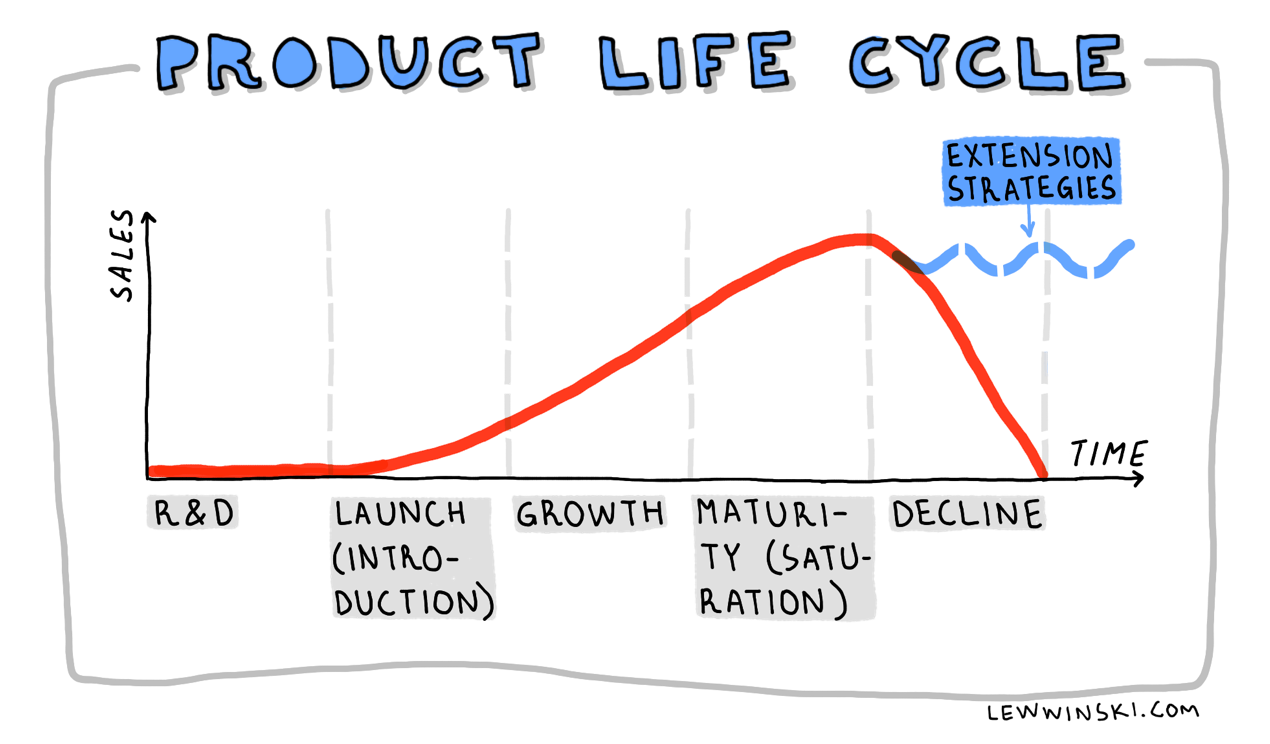
Market development
Market development is one of the strategies from Ansoff matrix.
It refers to selling existing products in new markets.
Redesigning
Redesigning is an extension strategy that refers to modifications of existing products.
You probably heard of “limited edition” of different products, so the purpose of them is actually to prolong sales of an old product.
Targeting new segments
Targeting new segments is an extension strategy that is similar to market development.
The difference is that market development often refers to new geographic locations, while new market segments often refers to the same location but new kind of people (with different lifestyles, or different ages, or different occupations).
However, essentially, new segments and new markets may be synonymous.
Price reductions
Price reductions refer to an extension strategy when price cuts encourage higher purchases.
Seasonal sales of clothes are an example of this strategy.
Repackaging
Repackaging refers to changing the package of a product without changing the product itself.
Differentiation
Differentiation is an extension strategy that refers to using the unique selling point in such a way that customers perceive the product or organisation as unique and different from those that are offered by competitors.
Brand
Brand is a combination of name, symbol and other characteristics that is associated with a certain business/product.
Branding
Branding is the process of attributing a set of characteristics to a business/product that adds value and differentiates it among competitors.
Brand awareness
😍 Brand awareness is the extent to which people are able to recognise a brand.
Brand awareness is very important at the launch stage of the product life cycle because the higher it is, the faster the product can reach the growth and maturity stage.
Additionally, promotion costs do not have to be that high for brands with high awareness compared to new unknown brands.
Brand development
👷🏻♂️ Brand development is a strategy that aims at strengthening the brand and improving its awareness.
Brand development, also, in way, acts as an extension strategy, because it helps to prolong the product life cycle.
The top achievement in brand development is when a brand becomes generic brand — this is when the product name is replaced with a brand name. For example, in the US most people do not say “tissue” or “napkin”, they say “Kleenex”, even though tissues/napkins are of a different brand.
Brand loyalty
🐶 Brand loyalty is customers’ dedication to make repeat purchases of the same brand.
It is usually improved via word-of-mouth (WOM — person-to-person oral communication) and brand ambassadors — celebrities who are using the brand in public appearances.
When people hear good stories/reviews about certain products/brands, they are more likely to purchase them more often.
Similarly, when people see celebrities use products of certain brands, it makes them feel that these brands are trustworthy and that they should use them too.
The biggest fear of marketing managers, in terms of brand loyalty, is called brand switching — when customers become disappointed in certain brands and start purchasing from competitors instead.
One of the ways to prevent brand switching is developing loyalty schemes — marketing strategies that are aimed at retaining customers.
An example of a loyalty scheme is when a coffee shop offers 10th cup of coffee for free, if you collect 9 stickers for purchasing 9 cups of coffee.
All sorts of membership cards and bonus points for repeat or larger purchases are also examples of loyalty schemes.
Brand value
💰Brand value is a premium that customers are willing to pay above the actual value of the product.
If a new unknown company creates a smartphone that is as good as iPhone, they will still not be able to change prices as high as Apple’s just because their brand is completely unknown and does not have much value.
This way, as in the smartphone example, brand value acts as an entry barrier to new market entrants.
Advantages of branding
Brand acts a legal protection due to copyright.
Branded products are protected from illegal copying.
Additionally, branding acts as a differentiation strategy, and helps customers to distinguish between different brands/products and provide a sense of uniqueness.
Besides, brands add value to products and increase customer loyalty, preventing people from brand switching and encouraging repeat purchases.
And lastly, all of the positive effects of branding result in increased profit margins.
Disadvantages of branding
Brand development is costly and time-consuming and there is no recipe how to make a successful brand: it is always a unique and special story and case study.
Additionally, good brand does not mean good product… So, very often, reliable and trustworthy brands produce unreliable and inferior products that result in decreased brand value that acts as a stigma even for successful products.
And lastly, from customers’ perspective, they are very often overpaying for “feel good factor” — there is nothing special in a product and there are a lot of good alternatives, but they end up paying more just because purchasing a certain brand makes them feel good.
Price
Price is the amount of money required/given in payment for something.
When it comes to marketing mix, it refers to the decision about the appropriate pricing strategy.
Cost-plus pricing
Penetration pricing
Loss leader pricing
Predatory pricing
Premium pricing
Dynamic pricing (HL)
Competitive pricing (HL)
Contribution pricing (HL)
Cost-plus pricing
Cost-plus pricing is a pricing strategy whereby managers add a markup to cost in order to determine the price.
Markup is a percentage that is added to direct costs of a product. It is not the same as profit margin! If markup is direct costs plus percentage, then profit margin is profit divided by revenue.
On the one hand, cost-plus pricing ensures that costs are covered.
On the other hand, it disregards competitors’ prices and other qualitative factors.
So, if competitors offer products that are similar in quality but are lower in price, then cost-plus pricing might not work.
Penetration pricing
Penetration pricing refers to setting a low price in order to penetrate the market and attract more customers.
This strategy is usually used either by new businesses or by existing businesses that offer new products.
Either way, organisations that use this strategy try to increase their market share and attract customers by offering a low price.
On the one hand, penetration pricing allows organisations to increase sales and increase brand awareness.
On the other hand, high market share and high sales volume do not necessarily mean high profitability…
Additionally, brand value might be at risk because, very often, cheap products are associated with inferior quality.
Loss leader pricing
Loss leader pricing refers to selling some products at a loss in order to attract more customers to buy other products.
On the one hand, loss leader pricing attracts potential customers and works well for FMCGs (see what that is in the first part of this class).
Besides, it might cause brand switching (this is also something we discussed in the first part of this class): when customers are driven by low prices to buy brands that they are not used to purchase.
However, this strategy only works only if customers purchase other products, otherwise the organisation will experience loss.
Predatory pricing
Predatory pricing is a temporary measure to squeeze competitors out of the market by offering lower prices.
If several competitors try to use predatory pricing against each other, it turns into a price war.
Customers might benefit from price wars in the short term and purchase products at low prices, but in the long term it might result in monopoly, if eventually competitors are defeated in the price war.
On the one hand, predatory pricing is quite an effective measure to increase market share.
Additionally, it serves as a high entry barrier to new new market entrants, who will not be able to succeed unless they are able to offer low prices.
On the other hand, this strategy is not sustainable in the long term because it will simply drive the organisation to loss.
Besides, it is unethical because it encourages unfair competition and it is even banned and illegal in some countries.
Premium pricing
Premium pricing means setting a high price for premium high-quality products (designer clothes, supercars, luxury watches).
Premium pricing creates a brand image of something scarce, unique, special, expensive, not affordable by most people. It is not applicable to low-quality bargain products.
On the one hand, premium pricing allows organisations to enjoy high profit margins.
Additionally, it increases brand value.
On the other hand, with this pricing strategy, sales volume (quantity) is usually quite low. Besides, this strategy is inapplicable to some products.
Dynamic pricing
Dynamic pricing refers to a strategy whereby prices change depending on the circumstances (time, demand, supply, etc.). For example, airline tickets price change.
On the one hand, dynamic pricing is flexible and gives a chance to maximise profits in the given situation.
On the other hand, it is not applicable to many products and may cause customer dissatisfaction (imagine all supermarkets raised the prices for umbrellas when it started to rain).
Competitive
In competitive pricing strategy, price is determined based on competitors’ prices. This pricing decision is market-oriented and relies on a thorough market research.
On the one hand, competitive pricing ensures sales: since organisation’s prices are comparable to those of competitors, it is evident that some customers would purchase organisation’s products, given that they are in line with their preferences and reasonably priced, compared to alternatives.
Additionally, this strategy helps to encourage brand loyalty : customers will not be enticed to switch to another brand because of lower prices.
However, in this strategy’s there is too much reliance on competitors who might deliberately manipulate prices in their favour, which makes this pricing strategy not sustainable in the long term.
Contribution pricing
Contribution pricing is when contribution is the main determining factor in a pricing decision. Contribution equals to selling price (P) minus average variable costs (AVC): Contribution per unit = P – AVC. Knowing total contribution and fixed costs, firms are able to set prices that allow to make profits and cover all costs.
On the one hand, with contribution pricing, profitability is ensured because it is the ultimate goal of this strategy — to ensure profitability, to make sure there is enough money to cover all costs. Additionally, contribution is useful for special order decisions: when a customer wishes to purchase an unusually large quantity of product and, in return, asks for a lower price, contribution pricing will allow to see what is the minimal price that would still make sense for both the seller and the buyer.
However, this pricing strategy, similarly to cost-plus pricing, disregards competitors’ prices and other qualitative factors.
Price elasticity of demand (PED)
Price elasticity of demand (PED) - refers to the extent to which demand is affected by price changes. It is calculated by dividing the percentage (%) of change (Δ) in quantity (Q) demanded (D) by percentage (%) of change (Δ) in price (P):
PED = %ΔQD ÷ %ΔP
Based on the results of this simple calculation, price elasticity can be:
Inelastic: if it’s between 0 and 1. It means that change in price doesn’t affect demand much.
Unit elastic: 1. It means percentage of price change equals to percentage of demand change.
Elastic: more than 1. It means that small change in price affects demand greatly.
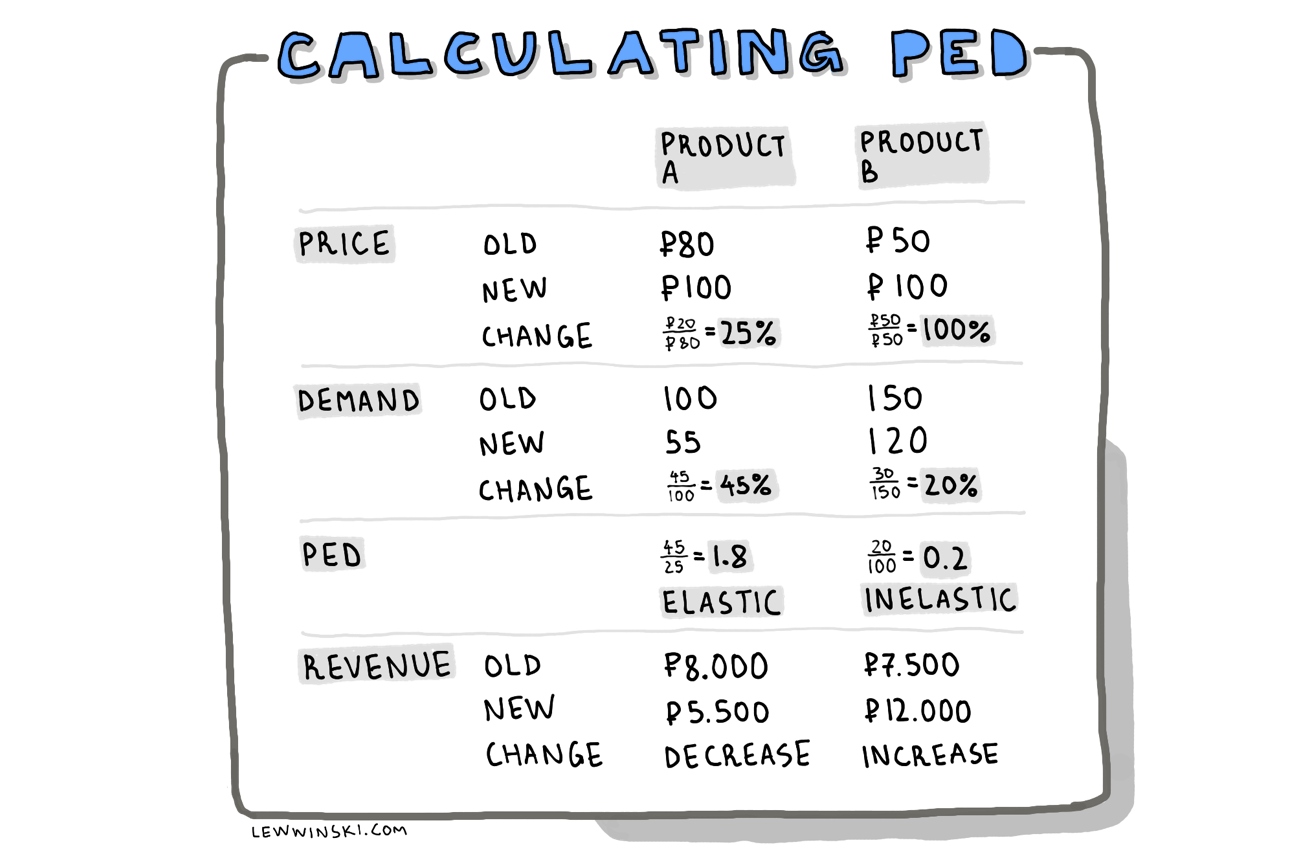
Tips
First of all, organisations do not have to stick to one pricing strategy only. They may use a combination of them, and, in reality, it is often a combination of strategies. It is important to know what pricing strategies are, though, in order to suggest/analyse different combinations of pricing strategies.
Secondly, there are plenty of factors that impact pricing decisions. Some of the factors that were mentioned in this part of class are PED, competitors, demand, seasons, trends and fashion, brand value and awareness, customer preferences, etc.
And lastly, since pricing strategies are strategies, SLAP rule for evaluation would apply really well as a way to discuss pricing strategies.
Promotion
Promotion means communicating messages about the product and/or brand to customers.
Promotion usually serves one or several of the following objectives: to inform, to persuade, to remind.
There are three aspects of promotion: above-the-line (ATL), below-the-line (BTL) and through-the-line (TTL).

ATL promotion
ATL refers to promotion through mass media, that is non-targeted.
For example, a TV commercial on a national TV station is an example of ATL promotion.
It is pretty much for everyone and the main goal of ATL promotion is to increase awareness about a product and/or a brand.
It reaches a wide audience but it does not guarantee immediate purchases.
Additionally, it’s quite expensive.
BTL promotion
BTL refers to direct, targeted promotion, not using mass media.
For example, sales promotion that is displayed in the shop window is an example of BTL promotion.
It targets only a specific group of customers and the main goal of BTL promotion is to secure sales.
It reaches a smaller audience compared to ATL, but, on the upside, it might cause immediate purchases.
Additionally, it is less costly than ATL.
Differences between ATL
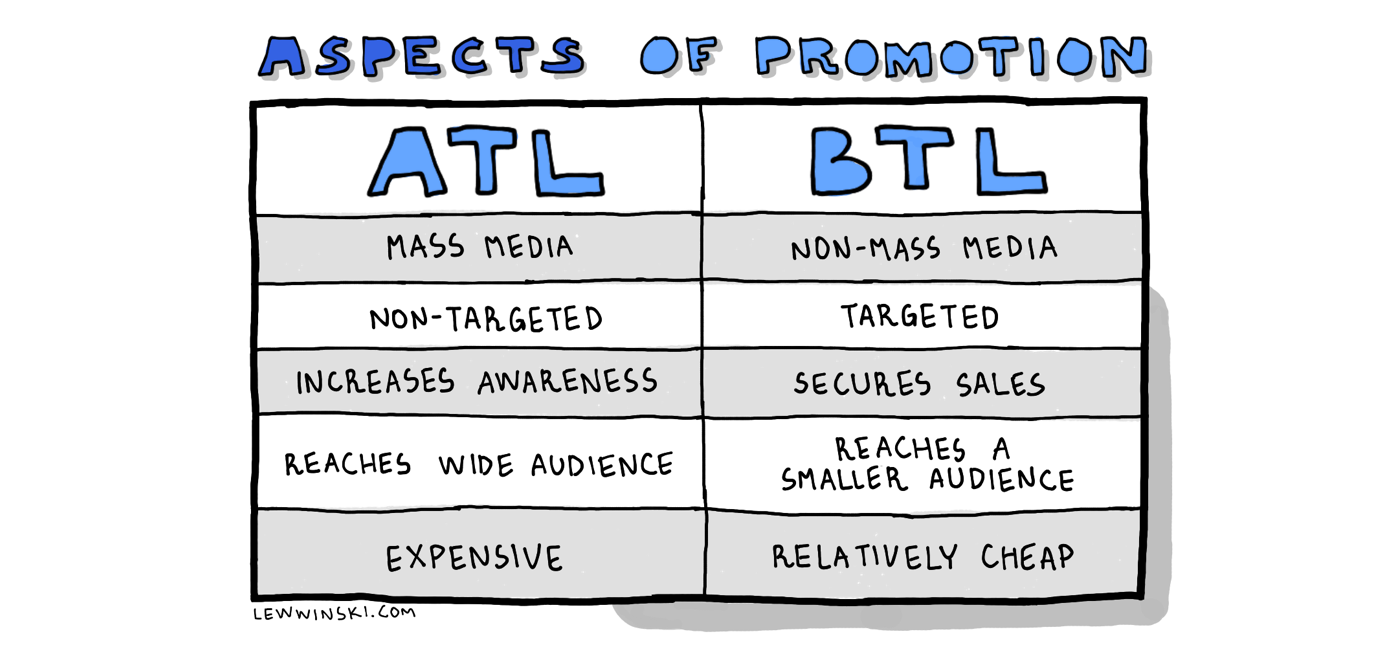
Through the line (TTL) Promotion
Nowadays, promotion often includes elements of ATL and BTL at the same time.
For example, when a nation-wide TV commercial is supported by in-store sales promotions.
Promotional mix
Includes advertising as an ATL decision of promotional mix and personal selling, public relations and sales promotions as BTL decisions of promotional mix.
These four decisions of promotional mix (advertising, personal selling, PR and sales promotions) can also be called forms of promotion.
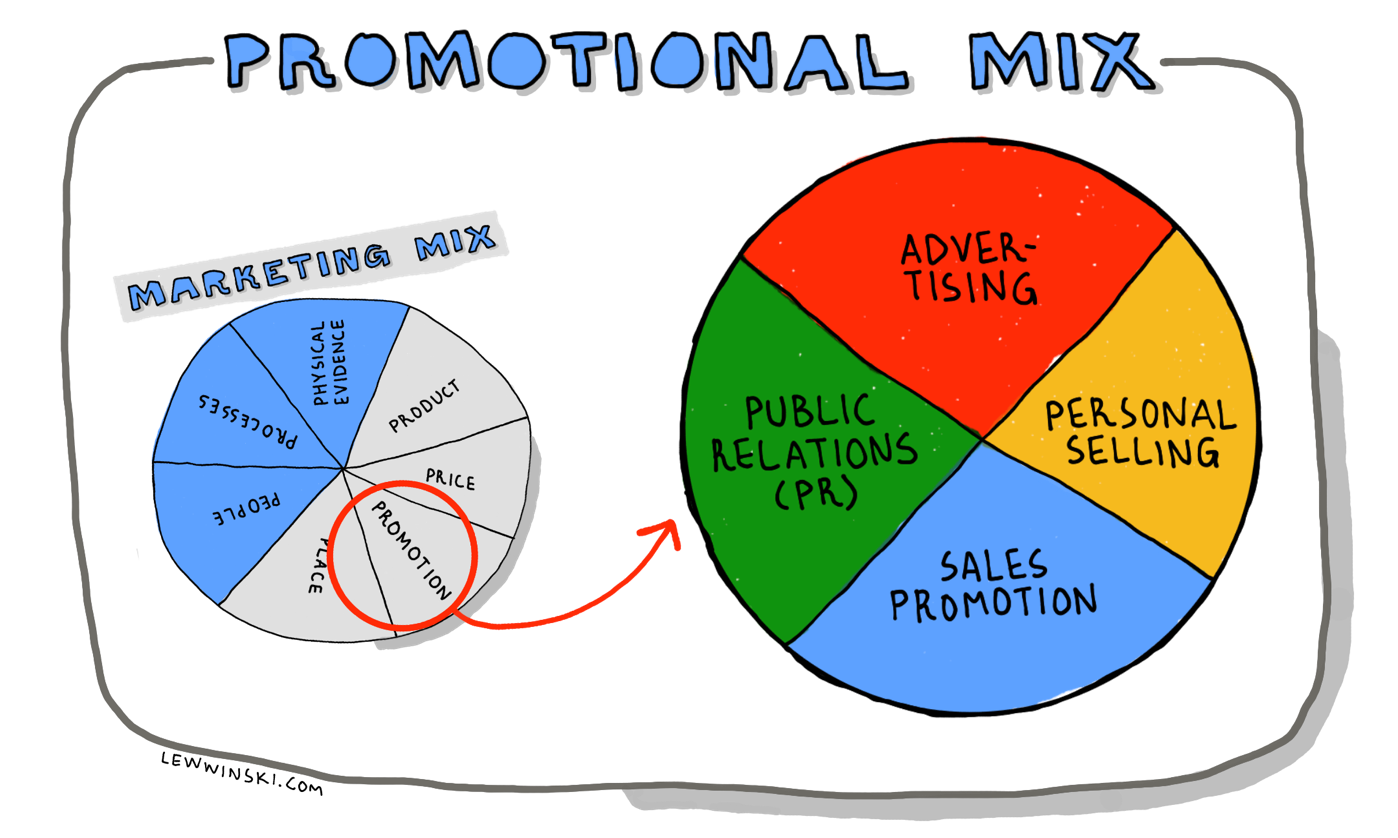
2 types of Advertising
It is usually divided into two categories: informative and persuasive. The purpose of informative advertising is to tell the customers about the features of the product.
It usually appeals to people’s logic. Some examples of informative advertising techniques are:
comparative advertising (when advertising includes comparison of product features with those of competitors’ products),
numerical factor (when advertising is providing a lot of numerical data about the product features).
The purpose of persuasive advertising is to convince the customers to buy the product. This kind of advertising usually appeals to emotion. Some examples of persuasive advertising:
bargain appeals (when customers are encouraged to buy more in exchange for a certain benefit, such as a discount that only works until the end of the day),
celebrity endorsement (when a celebrity is featuring an ad or commercial),
feel good factor (when advertising includes images of happy people that use the advertised product),
guarantees (when advertisement is promising certain conditions to buyers),
sex appeal (when advertisement includes sexy images),
slogans and jingles (mottos and short music pieces that reinforce brand image),
three yes technique (when advertisement asks questions that customers can potentially say “yes” to three times in order to achieve higher engagement levels).
Personal selling
It means person-to-person sales/purchasing experience.
Basically, it refers to what happens exactly at the time of purchase and how exactly sale is made.
For instance, sales managers in car dealerships, in-store shop assistants, telephone or videoconference sales are all examples of personal selling.
Public relations (PR)
It refers to professional maintenance of a favourable public image that includes promotional activities that are aimed at increasing the brand value, (re)positioning a brand/product, enhancing a brand image.
For some organisations, it’s important to maintain a positive image, however for some organisations it’s important to keep the buzz around them.
With regards to the latter, someone said “there is no such thing as negative publicity”, which means that it’s good as long as people talk about you, how they talk about you (in a good or bad way) isn’t that important.
Sales of promotion
It means short-term measures that are conducted in order to increase sales. For example, BOGOF (buy one get one free), coupons & vouchers, free samples, competitions, “free” gifts, loyalty schemes, discounts, prizes, etc.
Factors that impact choice of promotional methods
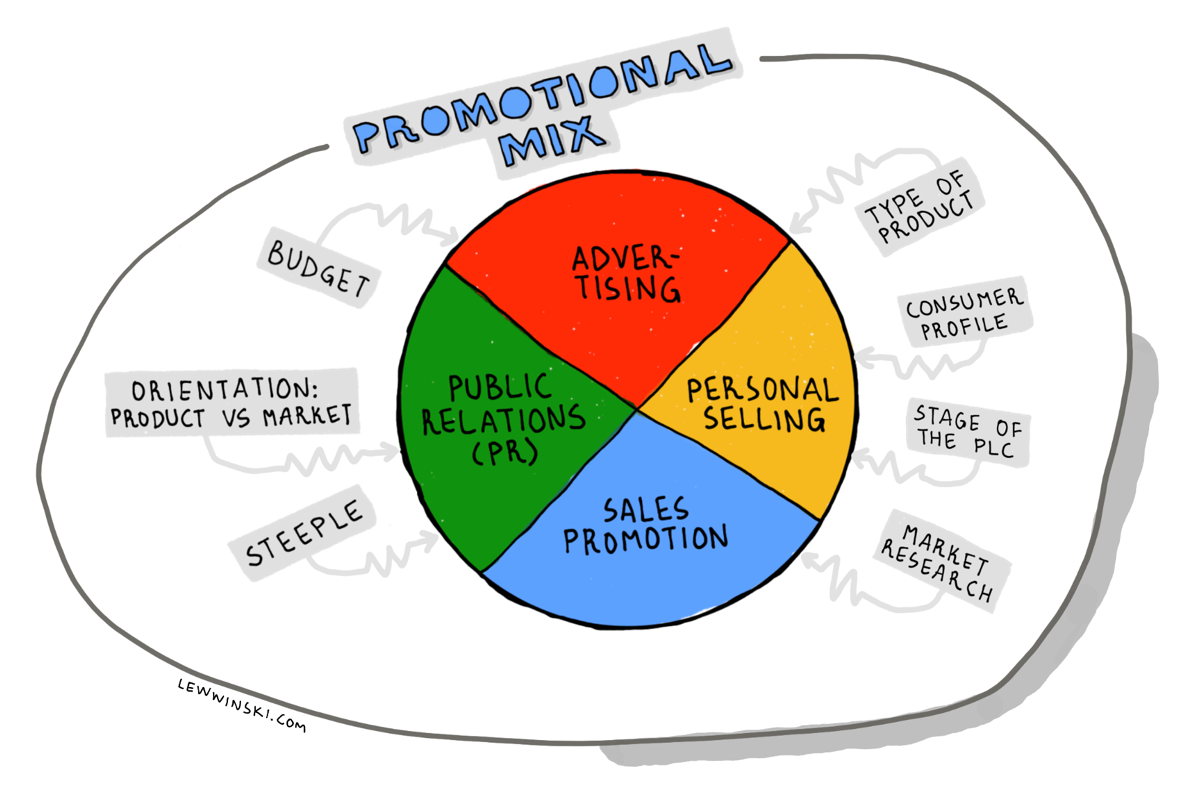
Promotional media
Promotional media - the means or intermediaries through which promotional activities happen: TV, radio, internet, etc. — we will talk about it in a moment.
Keep in mind, that one and the same promotional activity can be interpreted from several perspectives at the same time. For example, when company X shows a commercial on the central channel of country Y, it is:
ATL (from the aspects of promotion perspective),
advertising (from the promotional mix perspective), and
TV (from promotional media perspective).
With regards to promotional media, the ones that usually refer to ATL promotion are, of course, mass media: TV, radio, newspaper, magazine, outdoor advertising (for example, billboards or posters).
BTL promotional media are direct mail, publicity through brand ambassadors, word-of-mouth (WOM) and different events.
And medium that usually refers to TTL promotion (in addition to all of the above) is internet.
To be more specific, digital marketing is one of the main means of TTL promotion.
Digital marketing refers to marketing through digital tools and technologies.
One of the aspects of digital marketing is social media marketing (SMM).
SMM refers the use of social media platforms (Instagram, WeChat, YouTube, Twitter, etc.) to promote a product and/or brand. The advantages of SMM are:
Clear KPIs and metrics. For ATL, it is impossible to know how many people purchased a product right after they saw an ad, but with SMM it’s really easy to do as long as customers click the link and make a purchase.
Direct response. Again, unlike traditional promotional methods, the time between promotional activity and potential purchase is minimal: customers can click and buy only a few seconds after they see an ad.
Cost-efficiency. SMM is relatively inexpensive (compared to ATL) and it is easy to measure its success. Thus, for minimal budgets, organisations may get fruitful outcomes.
Improved brand awareness and new segments. Young people, do not really watch TV and are very critical about traditional ATL methods, so SMM helps to target those market segments that are not responsive to ATL.
However, despite all the advantages of SMM, only small potion of internet traffic results in actual real purchases and profits…
So, even though the role of digital marketing and SMM is increasing, it is still complementary to traditional ATL and BTL marketing.
With regards to SMM, our class objective was to learn to discuss it as a strategy, so in addition to the pros and cons above, you may also apply the SLAP rule to make judgements about SMM strategies of different organisations.
Place
Place (distribution) refers to the decision with regards to how products reach the end consumer or user through different distribution channels (chain of people and organisations that a product goes through on its way from producer to end consumer).
This decision is about delivering the right product to the right consumer at the right place at the right time.
These people and organisations that a product goes through on it way to end consumer are called intermediaries.
There are all sorts of intermediaries, but I believe the most common ones are: retailers, distributors, agents, wholesalers, car dealerships and vending machines.
The more intermediaries there are between the producer and end user, the more levels there are in distribution channels.
We are going to learn zero-level, one-level and two-level distribution channels.
Focus on pros and cons, apply the SLAP rule.
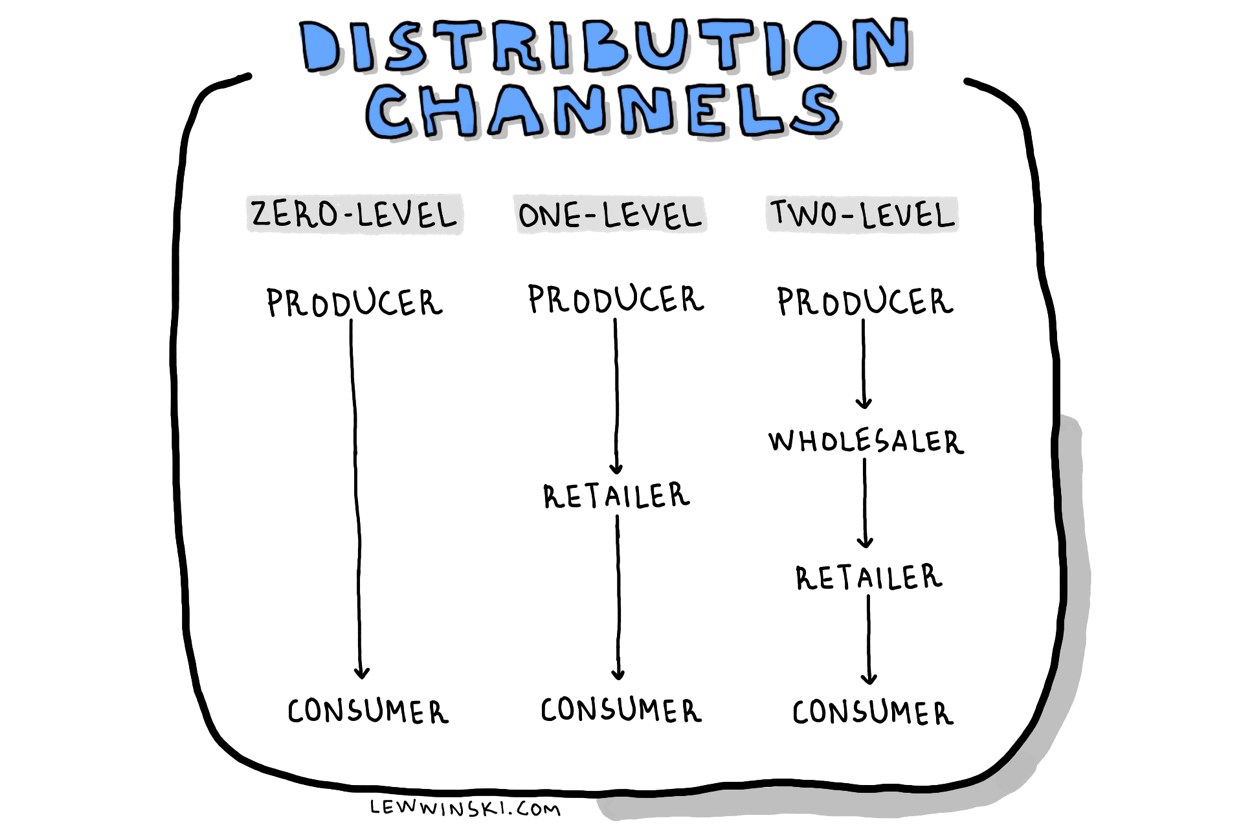
Zero level distribution
Zero-level is a type of distribution channel that has zero intermediaries.
Products are sold to consumers directly from the producer. Some examples of this type of distribution are: e-commerce, mail order catalogues, booking a room directly in a hotel. In all cases, consumer deals directly with the manufacturer/provider.
On the one hand, zero-level distribution allows producers to enjoy high profit margins. They can charge the same price as other businesses that use intermediaries, but they do not have to share profits with intermediaries. Or, since there are no intermediaries, these organisations may charge lower prices, thus increasing sales and attracting more customers.
Additionally, in zero-level distribution, there is full control over distribution because organisations do not have to rely on intermediaries in the distribution process.
However, since there are no intermediaries, there isn’t anyone who can take care of distribution.
So, organisations have to deal with logistics: transportation, customer service, after-sales care, etc.
One level distribution
One-level is a type of distribution channel with one intermediary.
Premium goods and goods in high quantities are usually sold this way.
Premium goods, such as designer clothes, have to be sold in premium stores to maintain a brain image.
In addition, premium goods producers have to control distribution and make sure it's up to the highest standard.
That is why, usually they use only one intermediary.
For those producers that manufacture large quantities of goods, it is difficult to sell them piece-by-piece, so they usually rely on an intermediary that breaks the bulk and deals with personal selling.
Examples of intermediaries on one-level distribution are retailers, or distributors, or agents, or car dealerships (only one of these at a time, of course).
On the one hand, retailers (the most common type of intermediary in one-level distribution) are in change of distribution, storage and sales.
Producers do not have to deal with all that and it is very convenient to sell large quantities of goods at the same time to only one organisation, compared to selling goods slowly one-by-one to multiple consumers.
However, with this convenience comes reliance on retailers: if they are not trustworthy, then their shortcomings will have an impact on producers' brand image…
Additionally, since retailers (or whatever other intermediary there is) have to earn money too, so either products are sold at higher prices (compared to zero-level distribution) or producers have lower profit margins, in order to cut the price for retailers to make sure the end consumer gets products at a low price.
Thus, it is either lower profits margins for producers or higher prices for consumers.
Two level distribution
Two-level is a kind of distribution channel with two intermediaries.
It works well when producer is far from consumer (thus there is a need to have many intermediaries in between) or for really large quantities of goods (thus there is a need to break the bulk twice).
The typical examples of two intermediaries in two-level distribution are wholesalers and retailers.
On the one hand, this type of distribution channel allows to have a wide coverage of geographic locations and build an extensive distribution network.
Additionally, similar to one-level channel, organisations may enjoy sales of large quantities in a short time.
However, there is even more reliance on intermediaries and even higher prices and/or lower profit margins compared to one-level distribution.
People
People is the element (decision) of the marketing mix for services that is concerned with employee-customer relationships.
Employee-customer relationships refer to all the interactions and communication between people who provide a service and people who purchase it.
Employees’ appearance (for example, uniforms they wear), manners and attitudes, the way they provide feedback to customers, communication, response to complaints are all examples of decisions that have to be made when thinking about the people element of the 7Ps.
Services are produced and consumed at the same time, that is why employee-customer relationships are extremely important as they are the essential element in the provision of services.
Types of culture
National (or ethnic) culture, for example: Chinese culture, Russian culture, Indian culture, Spanish culture, Arab culture, etc.
Organisational culture.
Cultural gap
Cultural gap means cultural differences that prevent mutual understanding.
If, due to cultural differences, employees are not able to communicate well with the customers, then customers might not enjoy their purchasing experience and it will result in brand switching or decreased brand value for the seller.
Processes
Processes refers to the element (decision) of the marketing mix for services that is concerned with the purchasing experience.
Simply speaking, processes are about how exactly purchase/sale is made and/or product is delivered.
Some examples of processes are delivery, customer service, payment methods, waiting times, queueing times, etc.
If processes decision is made, then there is some uniformity and standardisation in how services are provided.
Not only it allows to maximise the chances for positive WOM, but also it becomes easier for managers to trace shortcomings and improve.
If there is a system in place to collect feedback from customers about different aspects of service provision, then it is possible to improve.
If processes decision is ignored, it all becomes ad-hoc and responsibility is fully on employees’ shoulders.
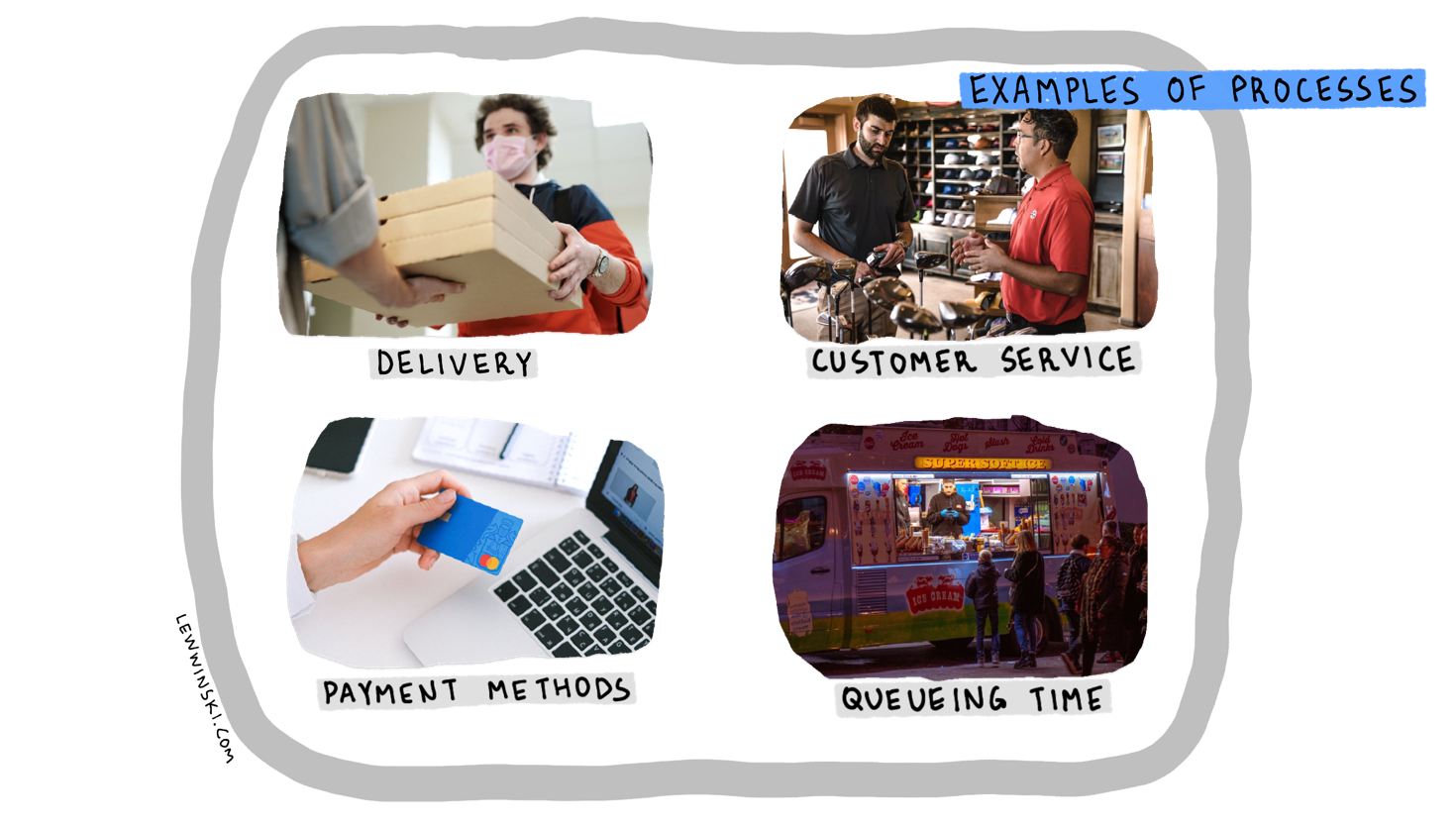
Physical evidence
Physical evidence refers to the tangible aspects of a service.
It allows consumers to evaluate and predict the quality of provided services.
For example, the star rating system for hotels is basically an indicator of physical evidence in the hotels measured by certain standards and expressed as a number of stars (from 1 to 5).
Some other examples of physical evidence in service-providing businesses are classrooms and facilities in private schools, equipment and materials used by barbers, car mechanics, manicurists, etc.
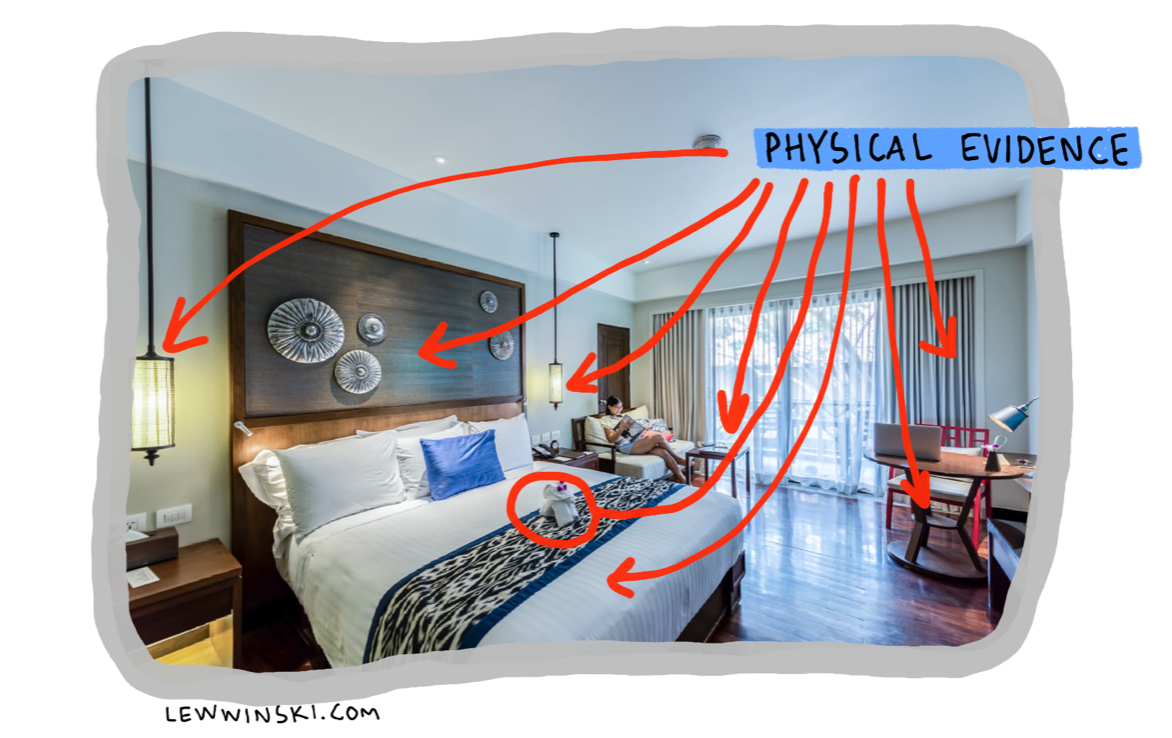
When physical evidence is appropriate and vice versa
If it is appropriate (for example, in a 5-star hotel there is designer furniture, original paintings and expensive decorations), then reality matches (or even exceeds) customers’ expectations, which might result in customer satisfaction and, as a result, customer loyalty, which will cause positive WOM promotion and have a favourable effect on brand value.
However, if physical evidence in inappropriate (for example, if premium perfume is sold in a dirty market stall), then customers are very much likely to get disappointed, which might result in negative WOM and brand switching… So, bottomline is that decision about physical evidence is extremely important.
Pros and cons of marketing mix
On the one hand, the concept of marketing mix (4Ps and 7Ps) is a straightforward and simple framework for marketing decisions and strategies.
It helps managers greatly to make sure they think about all the aspects of marketing before selling the product. It is, in a way, a checklist for managers to make sure they considered everything before making a decision about marketing strategies.
On the other hand, reality is more complicated than four or seven decisions and there is always something that does not go according to the plan or does not fit into the theoretical framework.
For example, many people argue that as long as product is of good quality and is offered at an affordable price, nothing else matters.